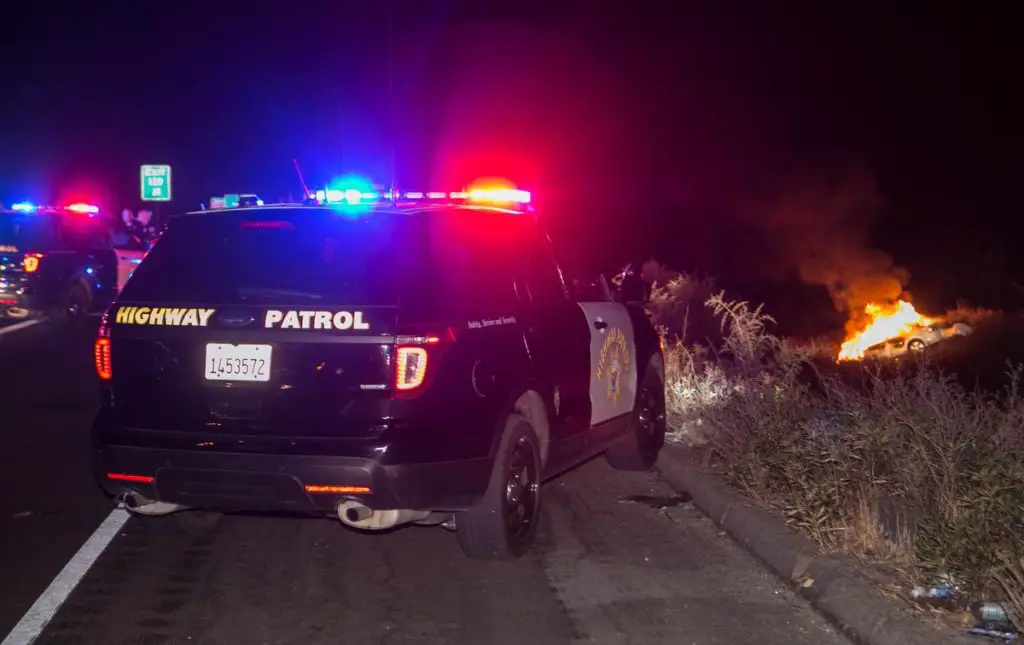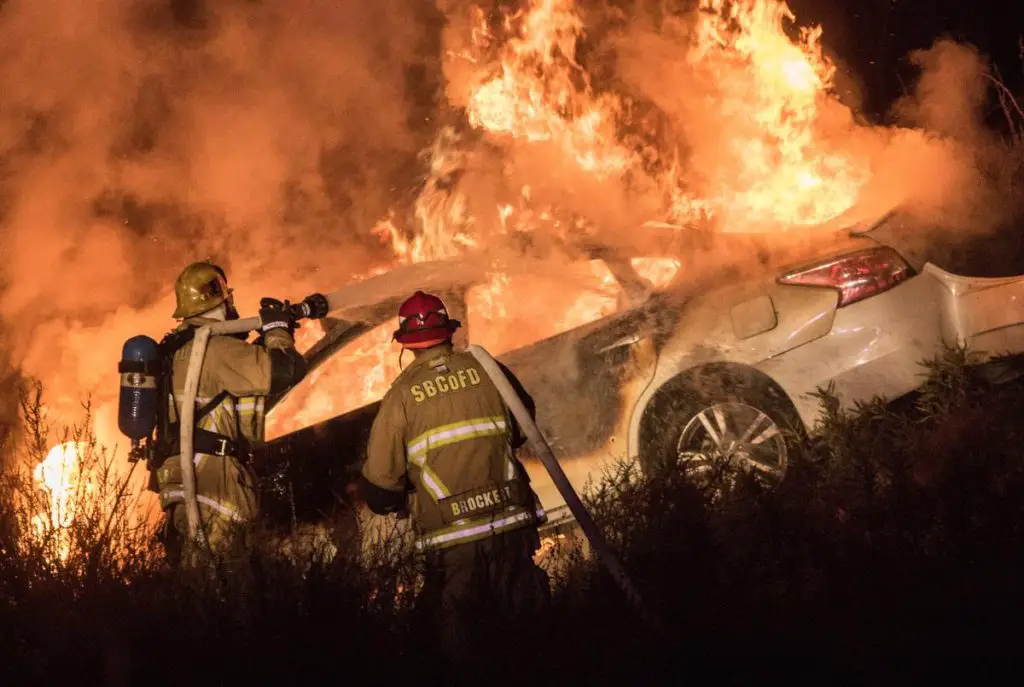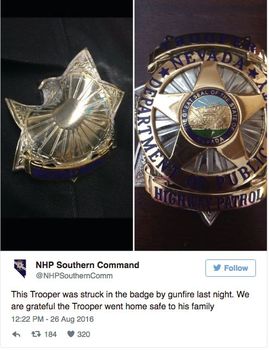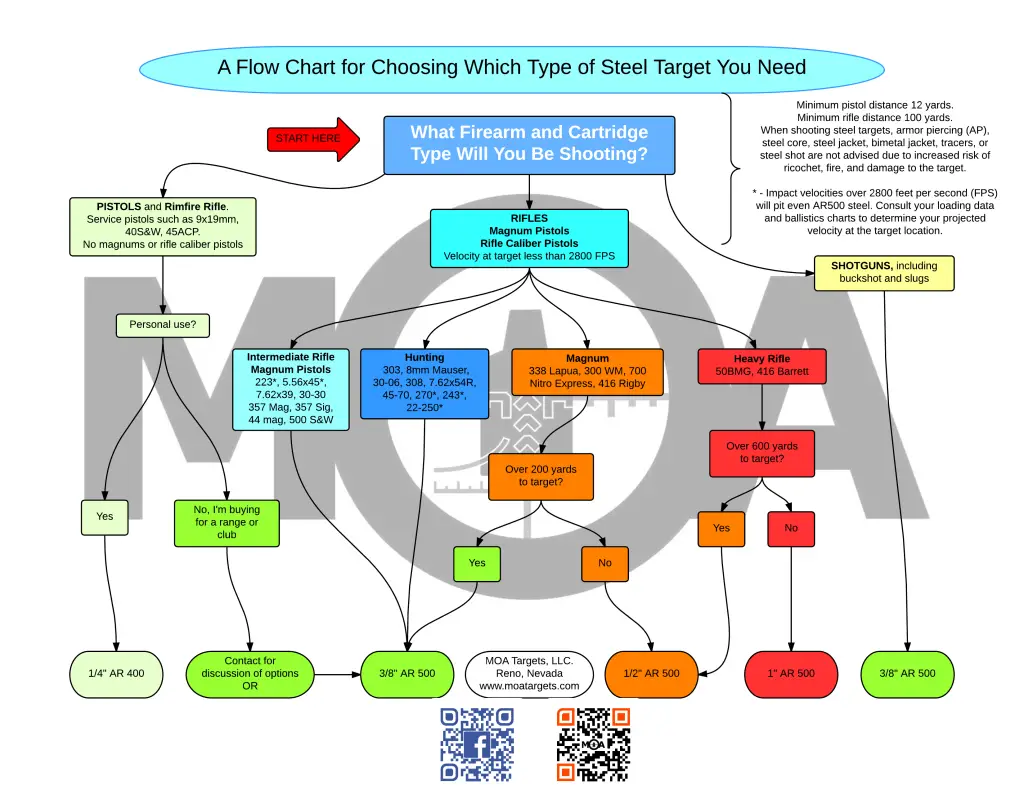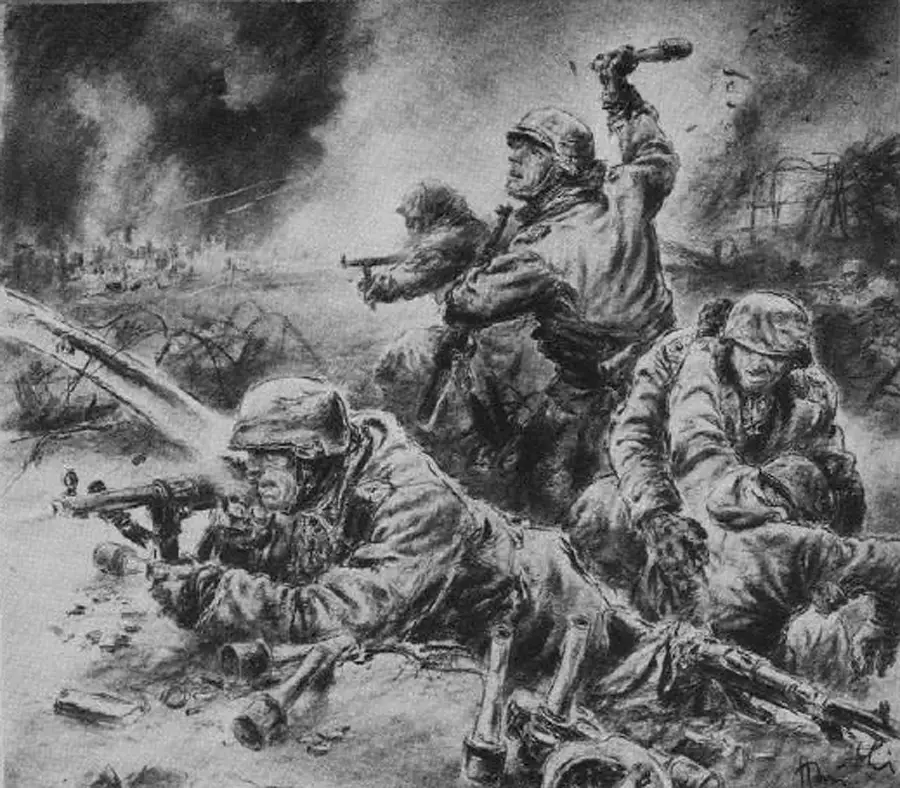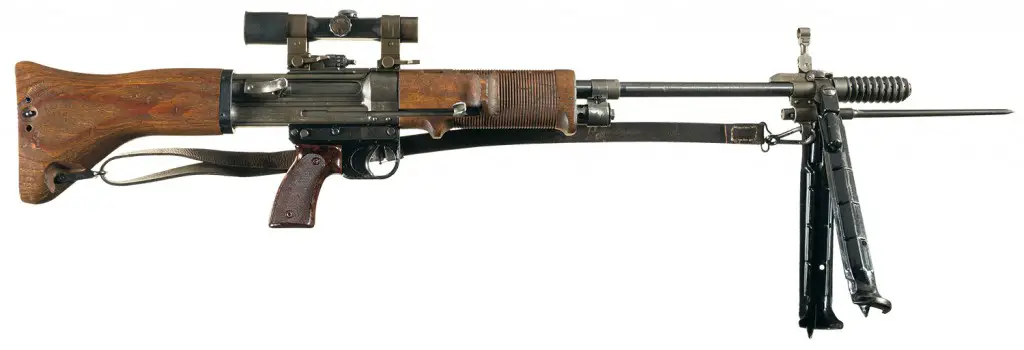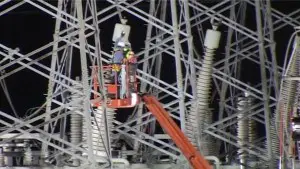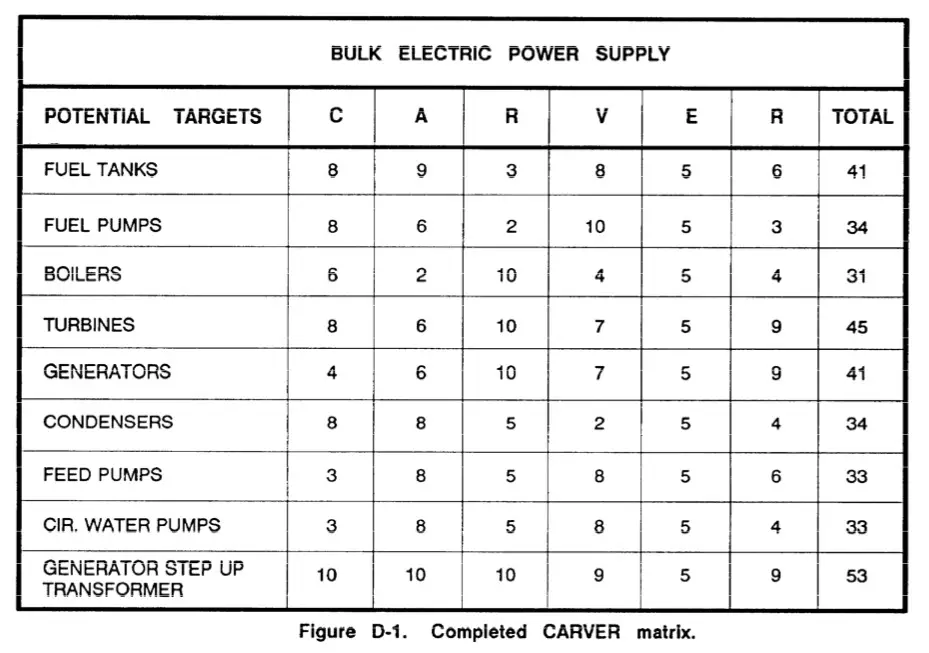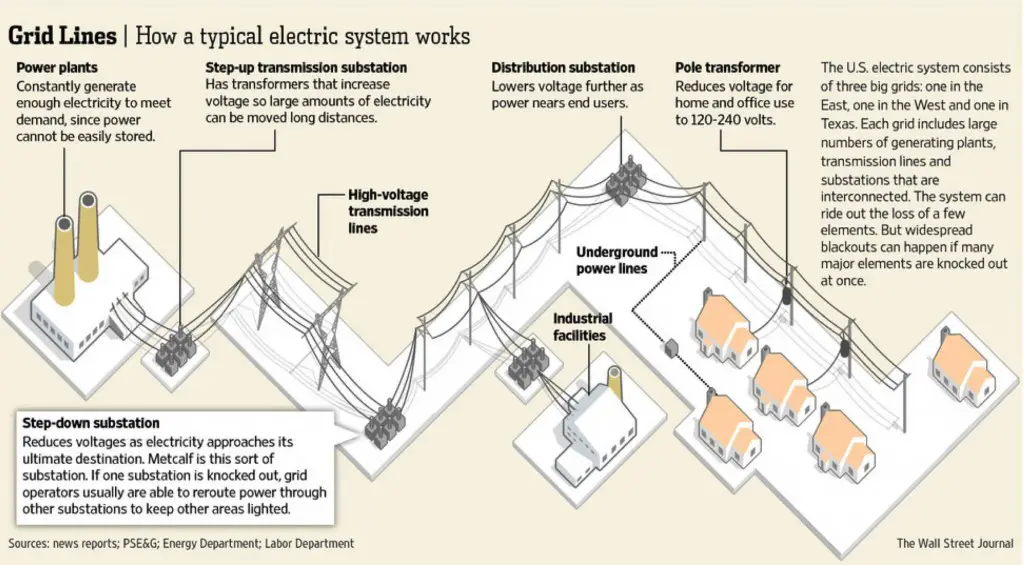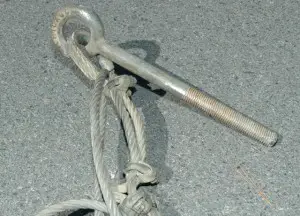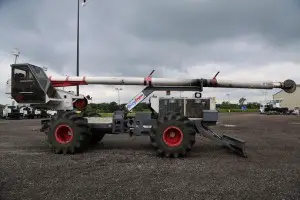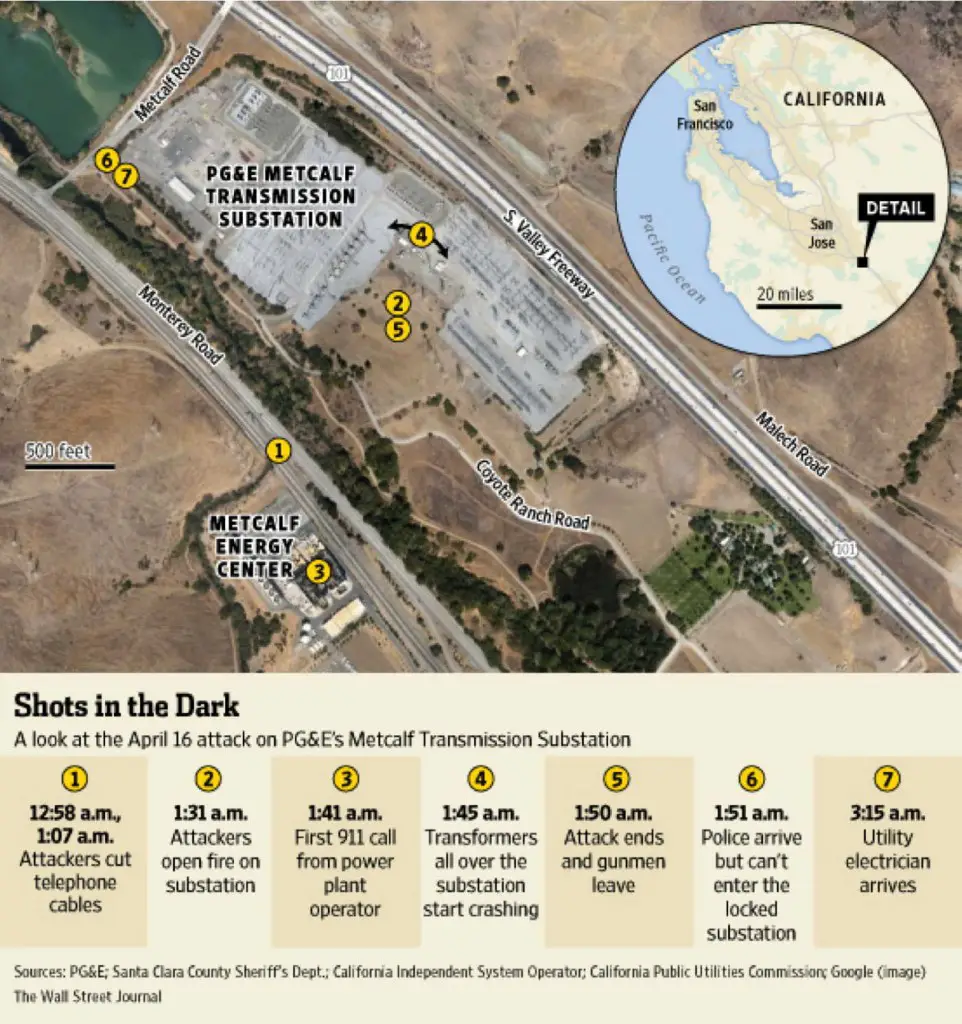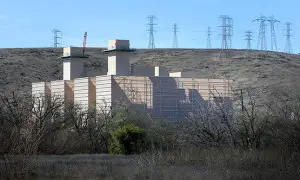Category Archives: Weapons Effects
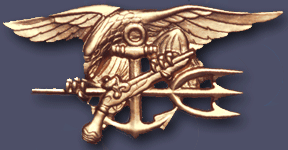 We’ve just heard the following story, and can’t vouch 100% for its truth, but it would explain something interesting: why, after using at least two suppressed weapons on a limited basis in Vietnam, and another thereafter, the SEAL teams did not pursue more general issue of suppressed weapons. (Two suppressed weapons they did use were the Mk 22 “Hush Puppy” variant of the Smith & Wesson M39, which added a threaded barrel, a suppressor, a raised sight axis (to clear the suppressor), and a slide lock; and a suppressed version of the S&W M76 submachine gun).
We’ve just heard the following story, and can’t vouch 100% for its truth, but it would explain something interesting: why, after using at least two suppressed weapons on a limited basis in Vietnam, and another thereafter, the SEAL teams did not pursue more general issue of suppressed weapons. (Two suppressed weapons they did use were the Mk 22 “Hush Puppy” variant of the Smith & Wesson M39, which added a threaded barrel, a suppressor, a raised sight axis (to clear the suppressor), and a slide lock; and a suppressed version of the S&W M76 submachine gun).
In the SEALS, there was a faction that was strong for suppressors as a force multiplier, and a faction that dismissed them as “spy [bleep]” and couldn’t see a practical use for them. So a test was arranged.
In the test, the SEALS, with the support of what was then the Naval Weapons Systems office at Crane, Indiana, tested a variety of US and foreign suppressed weapons in two like-real-life CQB environments: shipboard, on a ship destined for scrap, and ashore, in a Navy building that already was penciled in fora date with the wrecking ball.
Even with the quietest weapons, like the Hush Puppy with slide-lock engaged, there was no mistaking that a gunshot had been fired. The SEALS could hear the thud of rounds hitting walls, or the Spang! of them hitting ships’ decks or bulkheads. In addition, they could still hear the report, however reduced it may have been.
The SEALS concluded that the state of technology did not support a more general issue of suppressors at the time, because anyone the SEALS engaged would still know he was being engaged (at least, until they killed him).
By 2016 standards, this error forty-whatever years ago is clearly based on a false concept of what a suppressor does for you in combat. In fact, the gadget’s benefits are great even when they fall far short of the Hollywood effect of making the entire report of the shot disappear. Suppressors reduce noise and light signature, preserve operator hearing, help identify friend from foe, and mask the source and direction of friendly fires. Those reasons certainly justify using such tools.
But it took a while for the operators to learn that. Today, a lot more SOF (US and global) are running with suppressors, even though there’s still no way to keep the enemy from knowing that you’re shooting at him. At least, until you kill him.
Correction
This post originally named the Hush Puppy as the Mk 23. Daniel Watters points out in the comments (correctly) that the proper nomenclature is Mk 22 Mod 0. The error has been corrected. -Ed.
Badge Stops Bullet — Twice in One Day
In two separate incidents Sunday, would-be cop killers were thwarted, not by body armor, Stingray mass-surveillance boxes, the FBI’s PR budget, perfect police training, or any of that jazz.
Their bullets ricocheted off the cops’ badges, leaving the cops safe at home at the end of the day despite the criminals’ kinetically expressed intent.
The outcome for the would be cop killers was a bit different. The guy who shot a Nevada Highway Patrol officer was killed by gunfire from backup officers, and the other guys from his car sit in cells; while the domestic-abuser-turned-cop-attacker from Anaheim, California let cops and Highway Patrol troopers on a merry 85-mile chase before losing control of his car — and burning to death in the wreck.
Good preparation for his eternity, that.
About once every five years, a policeman in the US is saved by his badge, when the badge deflects a bullet. The last time was in New York City in 2010, reporte the New York Times. Last night, however, it happened to two different policemen in two states.
In Huntington Beach, California, officers were involved in a high-speed pursuit when gunfire broke out. A 10-year veteran of the Huntington Beach Police Department had bullets shoot through his windshield and strike him. But his badge stopped the bullets. The suspect veered off the road, crashed his vehicle and died of his injuries.
That’s a very telegraphic version of the story. The Orange County Register has more detail, including these photos, some of which are HBPD handouts and some of which are OCR staff photos:
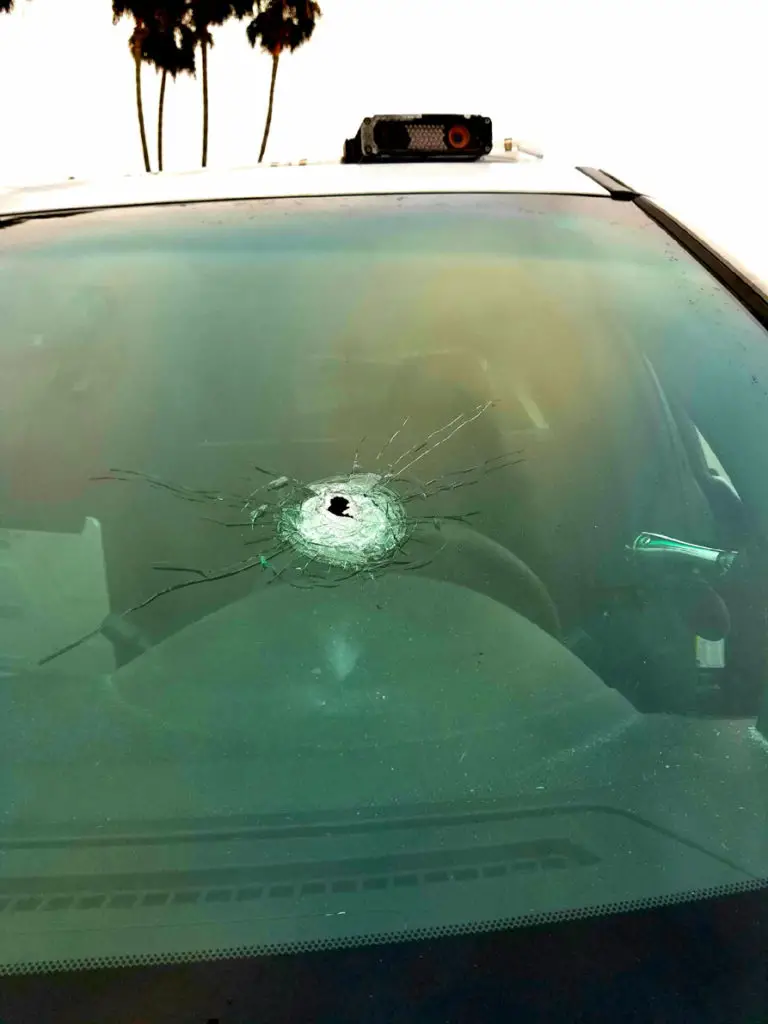
A hole in the windshield shows how a suspect shot at a Huntington Beach police vehicle, hitting an officer, but it deflected off his badge. “The round came through the front windshield of the officers car, struck the officers badge and deflected off,” said Jennifer Marlatt, a department spokeswoman.
If that doesn’t give you the creeps….
HBPD Statement:
Around 12:30 a.m. Friday morning, Huntington Beach Police initiated pursuit of a suspect for an unknown want.
He jumped in the car and fled from being arrested at a domestic violence situation, although the cops didn’t all know the “why” at the time they were chasing him.
During the pursuit the suspect opened fire on officers, striking one of the officers in his badge. Costa Mesa Fire was requested to evaluate the officer.
Apparently, Wife-Beatin’ Willie spun around in a U-Turn and fired at the approaching cops — that’s where he put the slug through the windshield and into the officer’s badge. Fortunately he was using a pistol and not a long gun with barrier blind ammo.
Officers lost sight of the suspect but were able to relocate the suspect as he entered the southbound 405 Freeway. The pursuit continued to the northbound 55 Freeway, Eastbound 91Freeway and then onto the northbound 15 Freeway where the suspect lost control of his vehicle and crashed down an embankment at Cleghorn Road, bursting into flames. The suspect was pronounced deceased at the scene. Huntington Beach Police and CHP are investigating. The pursuit lasted over an hour.
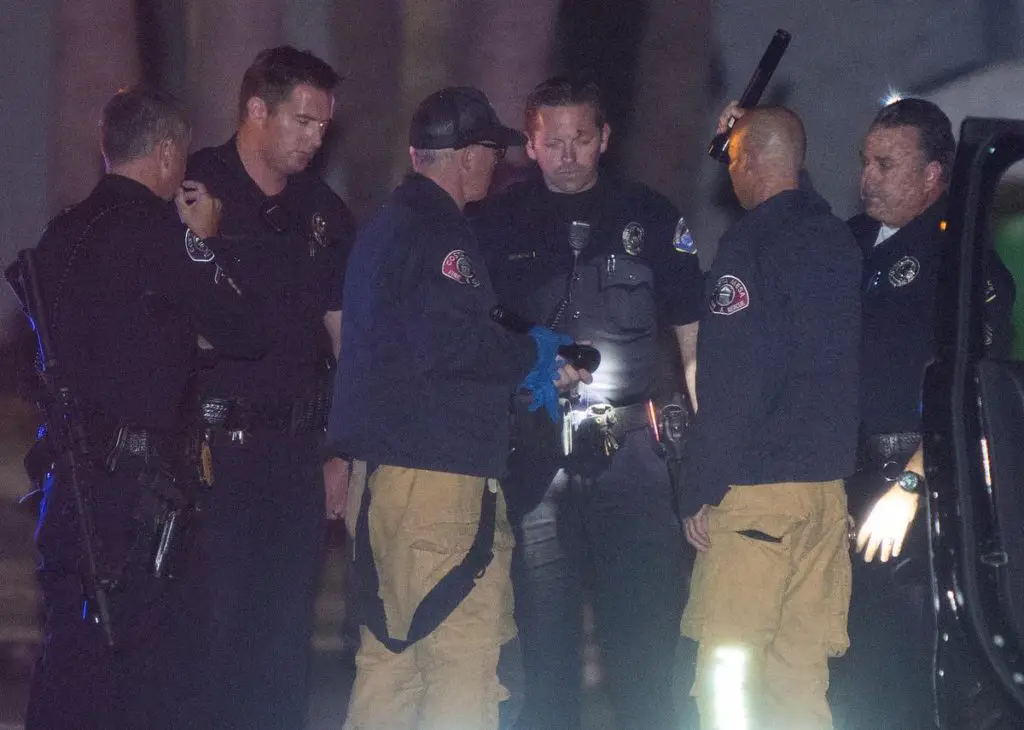
A Huntington Beach Police officer is checked out by Costa Mesa Fire after being shot in his badge during a vehicle pursuit of a suspect. The pursuit ended on the Northbound 15 Freeway when the suspect lost control of his vehicle at Cleghorn Road bursting into flames and killing him around 1:30 a.m. Friday morning in San Bernardino County.
They zoomed in on the badge:
HBPD’s badges are, unusually, made of steel, not bronze or aluminum.
You know, a fellow could get hurt doing that job. Of course, a fellow shooting at the people doing that job is almost certainly going to get hurt, and soon enough the suspect’s driving speed exceeded his driving skill, resulting in a rare literal crash and burn.
The crispy critter remains identified, as far as we know, at press time.
In Las Vegas, a Nevada State Trooper was conducting a traffic stop when the suspect began to flee the vehicle. During a foot pursuit, gunfire broke out and the trooper was struck in the chest. His badge saved him. The suspect died in the gunfire exchange.
The NHP Tweeted out this picture of the struck badge.
Two other occupants of the Nevada shooter’s car are in custody.
So, what are the lessons learned here?
- It is better to be lucky than to be good.
- It is
stupidterminally stupid to shoot at the po-po. In case you haven’t noticed, they come in whole troops or precincts. - Maybe if you’re the reincarnation of Fireball Roberts, you can outrun the police car, but you can’t outrun the police radio, or the helicopter that the CHP had following the runner. These things usually end in the reincarnation of no-fireball-in-particular. QED.
- Something has gotten into the water (or the media air), and lots of scroungy urban mopes and suburban wildsiders who would never have thunk of it, are down with firing up Officer Friendly in 2016. Is it the Black Criminal Lives Matter movement? The police “going fetal” in urban hellholes? The DOJ lining up behind the violent criminals? Hell, is it sunspots? Or does it even matter? It’s a fact out there.
Selecting a Steel Target
Water Balloons vs. Bullet
Here’s Sumdood from National Geographic, asking that question: How many water balloons does it take to stop a bullet — a .44 Magnum from a Smith Model 629, to be specific?
If you’re enough of a gun nut to read this site regularly, you’ll be pretty close to the answer, having seen other instances of firing into water. (In fact, it’s how bullets are recovered in crime labs, for forensic ballistics). But you’ll seldom see it given so much of a reality-TV build-up, with the payoff coming in slow-motion video.
The key bit is the slo-mo at the end, where they’re showing the bullet speed in fps as it declerates through each balloon. After the second balloon, the mighty .44 Mag is down to airsoft levels of fps, and it only goes downhill from there.
So why don’t they use water balloons as armor? Well, the first shot lets all the water out, and nobody fires one shot at you these days. Plus, it’s about as heavy as armor gets.
The Mauser K98k: a Commando’s View
These days, the venerable 98 Mauser has been elevated to a mythical position among the world’s firearms. It is, many writers say, the ne plus ultra of the military turnbolt repeater. To these fans, this position is demonstrated not only by its decades of service in every corner of the world, but also by its impact on every subsequent turnbolt, from the 03 Springfield and the Arisaka Type 38 (1905), to the Remington 700, Winchester Model 70, and Weatherby Mark V, all of which took something from the German original.
Yet there is an interesting fact about the Mauser’s history: while many nations were impressed by it and adopted it, the only major one to do so was the United States, who found its Krag-Jorgensen rifles and .30-40 Government rifle cartridge woefully outclassed by the Spaniards’ 1893 Mausers in the Spanish-American War. Superior rifles didn’t save the Spanish cause, but nobody who was on those battlefields had any doubt as to who had the best rifles.
The elevation of one of the volunteer regiments’ colonels, and an avid shooter and hunter, to the Presidency (that promotion itself the product of gunshots) might have had something to do with it. The British had a similar Mauser experience in the Boer War, and were close to the adoption of a rifle with numerous Mauser features (the Pattern 13 and ’14 Enfields) when war intervened and someone in the War Office thought it the wrong time to change. So they entered the Great War wedded to the SMLE Mk. I.
After the war ended, though, the British were satisfied with their SMLE. The French also didn’t think the Germans had a better rifle (even though most arms historians are pretty sure they did). Like the Americans and Russians, they were thinking about semi-autos for the future (France would later adopt an odd but serviceable turnbolt, the M1936). None of those nations came out of World War One thinking the Germans had better rifles.
And they didn’t enter — or exit — World War II thinking that, either.
Here’s a opinion worth noting from Peter Young. Who’s that? Well, to lay the whole thing out, it’s Brigadier Peter Young, DSO, MC, MA, FSA, retired. Or it was, when the wartime officer turned historian wrote the Foreword for John Weeks’s World War II Small Arms. In it, Young records being less than impressed with German rifles and riflery, even when it had its very best chance to make an impression on him:
It is interesting to see that the Germans, whose military skill is so much admired, were also capable of making mistakes. The production of the Model 98 Karabiner is a case in point. Having been missed by numerous German riflemen between 1940 and 1945, I have often wondered why the Germans, so skillful with mortar and light machine gun, we’re such rotten shots with the rifle. Well, now I know:
“Unfortunately,” the author writes (without considering my feelings!), “It was a relatively awkward rifle to shoot, and the bolt action was most disappointing. The sight radius was short, which did not make for good shooting.”
In Nº.3 Commando, which I commanded in Italy and Normandy, we were always glad to acquire Lugers or “Schmeissers”, and sometimes used the MG 34. Nobody ever bothered to keep a German rifle. The firepower of the platoon is a decisive factor in infantry combat, and by giving their men a rifle that was so much less effective than the Garand, or even the old Lee Enfield, the Germans were making life unnecessarily difficult for themselves at section level.
Now, that should put the cat among the chickens. Neither Glock nor H&K fanboys can hope to equal the shining, white-hot ardor of German WWII armament fanboys. But this is the word of one who most assuredly Was There™.
Weeks, in the book, does note the German attempts to leapfrog the 19th Century rifle: the G43, which was never built in large numbers, the MP.44, which he’s remarkably (and we think, unfairly) dismissive of, and the daddy of all German techno-fantasies, the FG.42: Weeks loves it as much as any other writer, but recognizes that its production in Wehrmacht-sized quantities was never a possibility. Even the much simpler K.98k with its decades of production engineering could never be built in quantities enough to arm Germany’s mass levies.
To some extent, what Young is describing is simply “the-devil-you-know effect”; not many Germans picked up M1s, either (although photographs indicate that it did happen). His Commandos’ taste for Lugers and MP.38/40 submachine guns may be partly explained by the British practice of being fairly stingy with the issue of the British analogues of these arms, especially the pistols.
The problem with the K.98k is, quite simply, that at the outbreak of of WWII its basic action was 40 years old, and based upon a design that was about a decade older than that. The many German experiments with upping their combat firepower at section level shows that the German Wehrmacht did indeed recognize that the shortened version of their World War I Gewehr 98 was only a stopgap when they introduced it amidst their rearmament program of 1935.
What’s “RHA” in Penetration Specifications?
Anti-tank, anti-armor, and armor-piercing ammunition needs to have a specification describing its penetration. Now, any scientific test would be buried in disclaimers and details. What muzzle velocity, what distance, what angle, what atmospheric conditions. But there are certain norms. It’s customary to convert ambient temperature and pressure during the test to an international standard atmosphere, 59ºF and 29.95 inches of mercury. It’s customary to convert slanted armor to its thickness equivalent along the axis of the shot. And it’s customary to describe penetration as distance, millimeters or inches, in a specific medium, RHA.
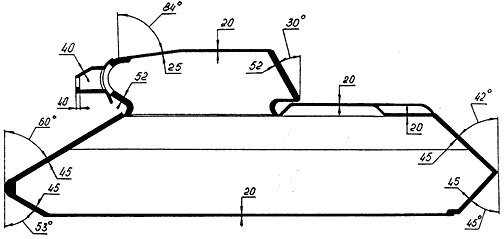
The Armor of this Russian T-34/76, with armor thickness and obliquity noted. On this specific model, nearly all armor was RHA (the 52mm thick turret front may have been cast).
RHA is Rolled Homogeneous Armor and it’s the most common of three types of steel armor that was commonly used in World War II. The others were Cast Homogeneous Armor and Face-Hardened Armor. In general RHA was the gold standard at the time, with CHA and FHA used for specific purposes. There are some terminological differences, of course: the British called RHA machineable armour, because it could be practically cut with machine tools; FHA was very difficult to cut on its armored face, due to heat-treating giving it a very hard, but brittle if overstressed, surface. RHA, conversely, is strong but ductile, which enables it to shuck off more and harder hits. The British breakout of FHA, which Americans call face-hardened armor, is flame-hardened armour.
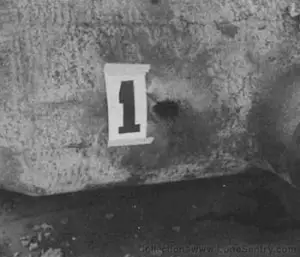
CHA Panther mantlet penetrated by US 90mm gun at 800m in Aberdeen testing. Only some guns and some specific projectiles could penetrate here.
The US transitioned to mostly RHA early, as did the USSR (all T-34 hulls were entirely RHA, and both RHA weldments and CHA castings were used for turrets). British and German tank production started the war using face-hardened armor, and changed midwar. All armies used cast homogeneous armor for some purposes. For example, the Germans used it in the commander’s cupola and in the mantlet or gun shield of all Panzer V Panther tanks. The US made Shermans with cast turrets and with both cast hulls and welded RHA hulls. The initial Panther model, Ausführung D, was made with face-hardened armor for the hull and turret (apart from the two cast parts mentioned above). In July 1943, they changed to RHA for the glacis (the upper front plate), and a year later they began using RHA on the sides.
As a rule of thumb, RHA is the best of these steel armors, with the best protection from penetrating and HE attacks, but it has some deficiencies. It is hard to form in anything but flat plates. CHA can be cast in almost any shape.
Heat treating is used to bring RHA to a specific hardness. The hardness of steel armor is measured on the Brinell hardness scale. As a general rule, the thicker the armor the lower the Brinell scale value, and therefore hardness of the metal, will be. The FHA plates of WWI armored vehicles, which were 1/8 to 1/4 inch thick, had a Brinell hardness of 420-650. The RHA for the WWII generation vehicles ranged from 220-390 or so. For example, these are the German specified values (for both RHA and CHA):
| Thickness Range (mm) | Brinell Hardness |
|
16-30 |
309-353 |
|
35-50 |
278-324 |
| 55-80 |
265-309 |
The reason for this decline in hardness with increase in thickness was the state of the production art, and it was fairly universal across the belligerents’ RHA armor. The Russians’ armor was the hardest by Brinell measurement.
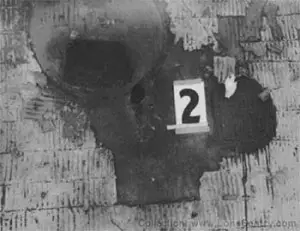
Penetration of a Panther glacis. This may have been FHA, judging from the Greens’ analysis of this series of Aberdeen tests.
FHA was hardened to a higher level (Brinell in the 500 range), but only a few mm deep. The idea was to have more resistance to penetration on the surface, but more ductility in the rest of the armor to prevent brittleness and fractures, or spalling of chunks off the inside of the armor. Spalling was the kill mechanism of the British HESH (High Explosive Squash Head) round of late-war was designed to produce. The US later produced a version called HE-Plastic or HE-P.
The more you study armor penetration, the stranger it gets. For example, a long rod penetrator like the APFSDS rounds used in modern tank guns can actually perforate armor thicker than it can penetrate, by causing failure in the armor plate; it can also perforate the armor deeper, through that failure mechanism. That’s completely counterintuitive, but penetration and perforation curves from live testing demonstrate it.
Late in the war, shaped-charge warheads became a problem. Using WWII-era understanding of lining materials and explosives, effective shaped charges tended to be larger than most tank main gun calibers. Instead, they were deployed by short-range rockets like the German Panzerschreck and the US 2.36″ rocket launcher, and other infantry weapons, such as Russian drogue grenades, the British PIAT and the Japanese lunge mine (which is exactly what it sounds like, a shaped charge on a stick for a suicidal human attack on tanks. They were used on Okinawa and were made in the hundreds of thousands for the anticipated defense of the home islands).
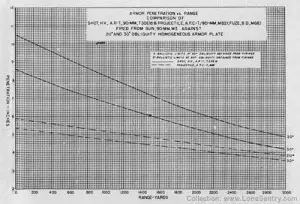
Penetration curves like this are typical of kinetic-energy penetrators, like these US 90mm shot types. Shaped charges do not depend on kinetic energy for their penetration, and thus, their effect on target is range-independent, as long as the delivery system can deliver the shaped charge to the target. The same shaped charge will work the same in a 3000-m ATGM or at the end of a 1.5 meter lunge mine.
The hardness of armor had much less influence on shaped charge penetration. But as a shaped charge has an optimum standoff distance, detonating it early reduces its ability to burn its way through armor. This led to various kinds of appliqué armor, some factory and some improvised. The Germans were a step ahead here. They had already added stand-off plates called Schürzen to many combat vehicles (including the Panzer III, IV and Panther) as a countermeasure against Russian anti-tank rifles. The Schürzen were homogeneous, but not very hard — only Brinell 105 or so. Schürzen were ineffective against conventional tank and antitank guns, but would sometimes fragment or deflect the steel or tungsten-cored 14.5mm Russian anti-tank rifle projectile, which otherwise could penetrate the side armor of those tanks at close ranges (~100m). The effectiveness of Schürzen against shaped-charged warheads was an unexpected but welcome bonus.
As we said, armor penetration is a weird science. The Schürzen, for instance, had almost zero effectiveness against the 14.5 if struck absolutely square on, at a 90º angle, but got much more effective as the angle increased even a few degrees.
Sources
Farrand, Magness, and Burkins. Definition and Uses of RHA Equivalences for Medium Caliber Targets. Interlaken, Switzerland: 19th International Symposium of Ballistics, 7–11 May 2001. Retrieved from: http://ciar.org/ttk/mbt/papers/symp_19/TB151159.pdf (That site has the whole proceedings of the symposium).
Green, Michael & Gladys. Panther: Germany’s Quest for Combat Dominance. Botley, Oxford: Osprey, 2012. (A very worthwhile book, rich in technical detail, with excellent notes and index and a wealth of photographs).
Uncredited, Armor-Piercing Ammunition for Gun, 90-MM, M3. Washington: Office Of The Chief Of Ordnance, January 1945. Retrieved from: http://www.lonesentry.com/manuals/90-mm-ammunition/index.html (Lone Sentry is a former W4, and is highly recommended for this sort of period material).
Numerous other sources were used en passant but the bulk of the information in this post is from Farrand et. al. and the Greens.
Weapons Term that Stumped Us: “Pronock”?
We don’t often run into a word referring to weapons that’s completely unfamiliar to us. Even more rarely, we can’t even track the word down. That’s what happened to us in reviewing a 1952 document by the Operations Research Office, a now-defunct FFRDC1 operated by the US Army at the time.
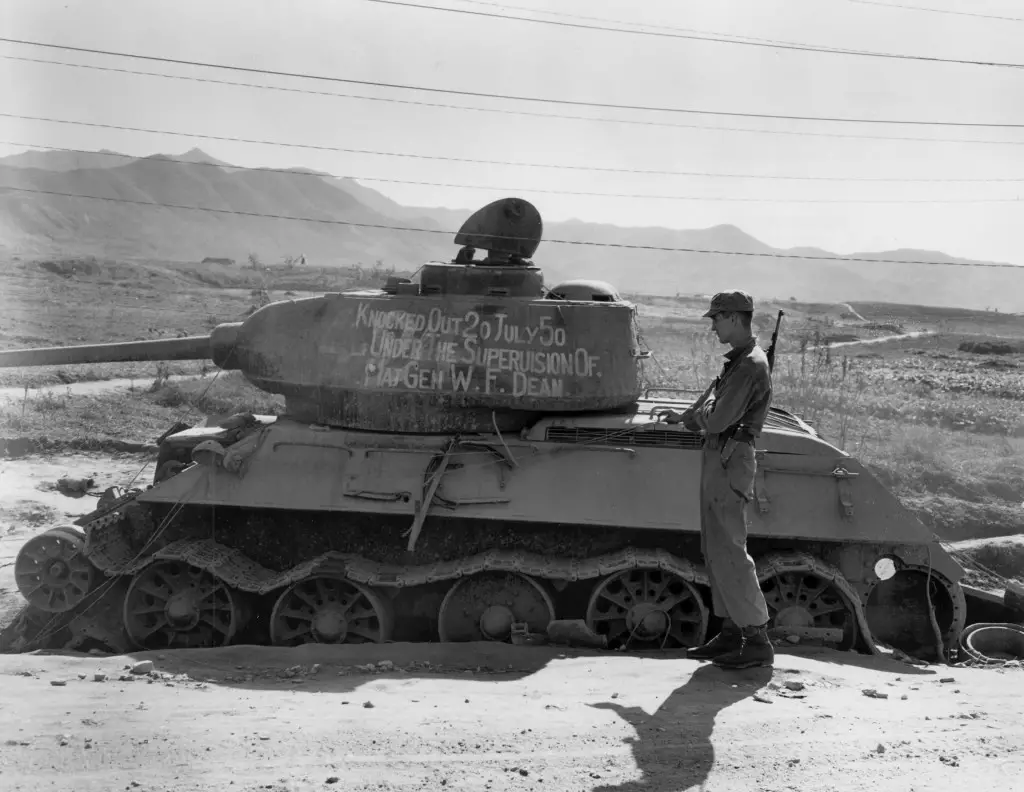
Even generals got in on the tank killing. Of course, this one wound up a POW, out doing a corporal’s job with a bazooka.
The document reviews the performance of US tanks and tank units in the first year of the Korean War. It was originally classified as SECRET, and the second of two volumes does not seem to have survived. The lost (?) second volume comprised Appendix K to the fundamental document: surveys of some 239 North Korean T-34 tanks examined by American ordnance experts. Fortunately, some conclusions from those surveys made it into the first volume.
But the original document is full of fascinating insights. One of them was that napalm was hugely successful against Nork T-34/85s, and was potentially a threat to American tanks. Napalm is mentioned nearly 60 times in the 308-page report. The mechanism of destruction wasn’t completely certain, but it appeared to be that the nape set the tanks’ solid rubber road wheels on fire, and the burning wheels got hot enough to cook off the rounds in the tanks’ sponsons. FOOM! End of tank, or as tankers say now, “catastrophic loss.” In 1952, the term was “loss, unrecoverable.” That described the situation where the burnt-out hull was here, the insinerated turret was there, and both of them had small, carbonized cinders of what had been the crewmen.
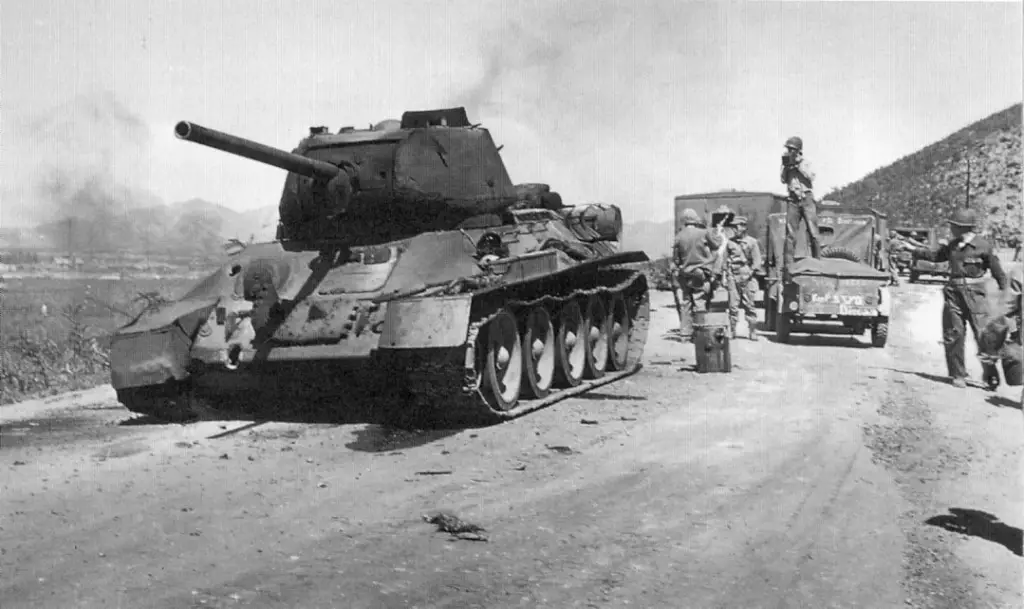
Unknown what killed this tank, but napalm is a possibility. It appears to be buttoned up, but still burning. Tough luck for the Norks inside.
On the basis of limited evidence, air attack accounted for 40 percent of all enemy tank losses in Korea, and 60 percent of all enemy tank losses caused by UN weapons.
On the basis of limited evidence, napalm was the most effective antitank air weapon thus far used in Korea. (p.2).
The difference between all enemy tank losses, and enemy tank losses caused by UN weapons is presumably the same thing that caused a lot of US/UN losses: mechanical failure. A table on p. 36 bears this out, and is discussed on p. 35:
On the basis of this record, the greatest single cause of loss in NK T34’s would seem to be UN air attack, which accounted for 102 out of 239, or about 43 percent of the total losses.
Napalm appears to be the most effective weapon of all, accounting for 60, or about 23 percent of the total count. Abandonments, in most instances without any visible evidence of cause, accounted for 59, almost another 25 percent of the total count. Tank fire was the third largest single cause, knocking out 39 tanks, or about 16 percent. (p. 35).
This led to a discussion of napalm’s effects:
Napalm as a weapon to defeat armor must be given rather special consideration. It is essentially a weapon of an accidental nature. With the possible exception of the relatively rare occurrence of a direct hit, napalm does not of itself destroy or seriously damage a tank. However, it is fully capable of starting a chain of events which may bring about the loss of the vehicle. A napalm bomb, if a hit is registered sufficiently close to the tank, will splash its burning fluid on the tank. Because of the fire, the crew may suffer burns or be induced to abandon the tank. However from the prisoner of war interrogations it appears that tank crews usually had sufficient time to get clear before the fire had spread (see Appendix D). However, the abandonment of the tank ultimately led to its destruction, for the napalm from the first or successive strikes had sufficient time to ignite the rubber on the road wheels, heat the ammunition to the point of detonation, and set fire to the fuel. Any or all of these factors brought about the loss of the tank. (p. 37).
Amplified, and considered in terms of US tanks in this partly redundant passage:
From a general examination of US tanks, the Air Force Operations Analysis tests of napalm against T34 tanks (FEAF Operationr Analysis Office Memo No. 27, prepared jointly with Deputy for Operational Engineering, FEAF, 30 October 1950) and the ORO tank survey (see Appendix K), it is belleved that napalm- caused tank fires are essentially “accidental” in nature, i.e.,
the napalm itself does not have enough energy to set ammunition or fuel afire by bating a tank, but it does have enough effect to set afire rubber bogie wheels , which In turn can fire the tank bilge or amnunition and thus kill the tank. Also, napalm entering through the air intake of a tank can set the bilge afire, again firing ammunition and killing the tank. It appears that both of these “accidents” can be eliminated by minor tank redesign or by fire extinguishing techniques. (p. 59).Not clear what killed these tanks, but our guess is that the Nork crewman in the foreground suffered a terminal case of amall-arms projectile sickness.
The USSR may conclude on the basis of the Korean campaign that napalm is a very effective antitank weapon. This possible conclusion can be vitiated by minor redesign of US tanks to reduce effectiveness of “accidental” fires. In future attack on Soviet-manufactured tanks, napalm may remain effective, but the types of fluid filler-such as “G” agents, chlorine trifluoride, or pronock — in improved napalm-type tanks may be even more effective. (p. 60).
There’s the word “pronock.” What is it?
But first, let’s continue our digression into the Korean War tank effectiveness report. The unexpected effects of nape on tanks got the ORO thinking. Some of the thoughts probably explain why the report was classified so highly in the first place:
On the basis of the burning of the rubber on tank road wheels with napalm, resulting in the destruction of the tank, tanks appear vulnerable to 40-kt atomic-weapons attack up to a distance of 2,500 yards on a clear day, and 2,000 yards on a hazy day. (p.3).
Er… yeah. T-34s were vulnerable to destruction by nuking. We’ll accept that.
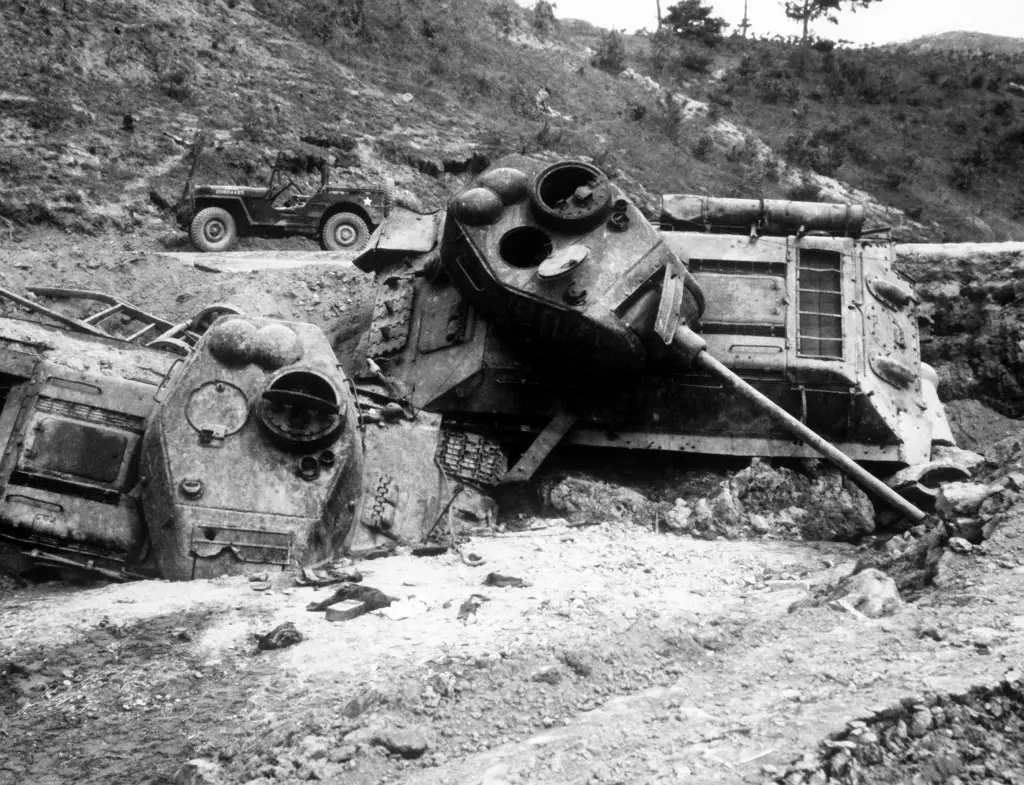
Original caption: Napalm Bomb Victims. Mute testimony of accuracy of close support missions flown by Fifth Air Force fighters are these Red Korean tanks, blasted out of the path of advancing 24th Infantry Division units near Waegwan, Korea.
AIR AND SPACE MUSEUM#: 77799 AC
And then there was a list of things that the US ought to develop, based on combat experience with tanks in Korea:
Support a vigorous and expanded research and development program to provide a balanced family of antitank weapons without, however, either overemphasizing or neglecting the role of heavy gun tanks such aa the US T43. This program should emphasize:
a. Development of an effective long-range antitank gun for use by the infantry. This gun should be capable of being moved over rough and unfavorable terrain, preferably in a light, highly mobile vehicle.
That, of course, is the paragraph that gave birth (by a circuitous route, it’s true) to the US M40 106mm recoilless rifle. The M40’s immediate ancestor, the M27, would be rushed to Korea and tested in combat.
b. Development of a family of lethal, influence-fused antitank mines s with sterilizing and arming devices, suitable for remining by rockets, artillery, and air.
Simultaneous development of corresponding mine-detection &vclearing devices.
That stands to reason.
d. Research and development on new types, of air and ground munitions utilizing liquid fillers, such as napalm, chlorine trifluoride, pronock, and G-agents.
That’s the strange use of the strange word, “pronock.” What is it? Napalm is well known. G-agents are nerve agents originally developed by the Germans: Tabun, Soman, Sarin, and Cyclosarin, known in the US/NATO coding system as GA, GD, GB and GF respectively.
Chlorine trifluoride is less well-known, but was a remarkable German “twofer” that produced both incendiary and toxic effects, and that was produced by the Third Reich’s chemical-warfare directorate as “N-stoff” or “Substance N.” The incendiary effect of ClF3 is pretty remarkable — it’s hypergolic not only with normal fuels, but also with water. And it can set asbestos on fire. It does bad things to human beings. It’s never actually been used in warfare (or in most other applications) because containing and handling it is a challenge; Rocketdyne once developed rocket engines that used this stuff as oxydizer with Hydrazine Hydrate as fuel. Hydrazine (N2H4), another Nazi product (as the fuel in the mixture “C-stoff”) used in the V1 and Me163, still has some uses (in the ACES ejection seat, IIRC), but is itself among the nastier things in the hazmat catalogue.
For completeness’s sake, the last of the list of recommendations:
e. Continued development of special amunition, such as shaped-charge and squash-head ammunition, together with improved bazookas and recoilless rifles.
But what in the name of science is “pronock?” It clearly is something that can be used as a tank filler, like napalm, like chlorine trifluoride, like the G-agents. And something that, like those substances, one would rather not have fall on him. Beyond that, we’re stumped. Google was not our friend, either.
Update
Looking for some photos of tank kills definitely attributed to napalm, we found this period article on napalm in Korea which depicts — unfortunately, in a very horribly reproduced half-tone — one of the tests of napalm on a captured T-34. It also describes the thickened gasoline’s composition, and effects on the enemy:
Red tankmen weren’t afraid of diving planes at first, their tough armor would repel 20 mm fire, it was hard to hit the maneuvering tank with rockets, and bombs had to be right on to kill a tank. Napalm was another story. Pilots drop the fire bombs short from low altitude, let it skip to the target. Accuracy is not at a premium. The napalm bomb will cover a pear-shaped area 275 feet long and 80 feet wide. A solid sheet of 1500° fire envelops everything , Killing personnel, exploding ammunition. It is not a flash fire like gasoline alone would be but clings and burns and burns.
… As fast as the Reds moved in tanks to stop the retreat, napalm was dropped on them. They ran out of tanks and weight of phases of the war have seen far fewer communist tanks in action.
The article noted two indirect effects of napalm on the enemy: tanks would be found with the crews inside, unmarked but dead of suffocation, the napalm fires having stolen the very oxygen from the air they breathed. And the psychological effects of the weapon induced many surrenders.
Notes
1. FFRDC: Federally Funded Research and Developmant Corporation. The most famous are probably RAND, which was sponsored by the USAF. The ORO was an Army/Johns Hopkins lashup, that the Army grew tired of and pulled the plug on in the 1960s.
Chill out, it’s only ionizing radiation
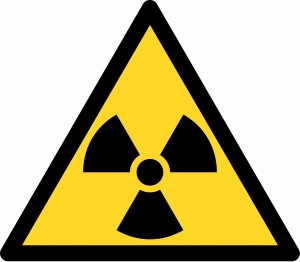 Recommended from the Comments — straight talk about soi-disant Dirty Bombs.
Recommended from the Comments — straight talk about soi-disant Dirty Bombs.
Recently we read a novel that climaxed as the heroes tried to stop a hostile force from using a radioactive weapon in an American City (think it was NYFC). And the radiation from this thing… had flesh falling off their bones in minutes as they tried to set it up, and then it set the building on fire.
With its radiation, you see.
There are novelists who do research, and then… there was that guy.
Anyway, Larry Grimm, who comments here from time to time, is a health physicist. We think it’s fair to say he’s learned more about the physiology of ionizing radiation than we have, and we know we know it better than that novelist fellow. Here’s a repost of a Q&A with Larry from seven years ago.
Q: What is the biggest concern from a radiological dispersion device?
A: Two things: the irrational fear it can induce and the expense of cleanup. The possibility of the radiation actually hurting anyone is quite small. We fear what we do not understand, sometimes irrationally. The concepts of radiation are poorly taught in high school, and the only other radiation information we get has been sensationalized by Hollywood, politicians, and those looking to make a buck off of our lack of education. You can beat the fear by learning how radiation works and how to manage it safely (protection techniques). Fear and panic kill people, as any good Marine knows. Radioactive materials are chemicals. Sometimes it is easy to clean them up, sometimes hard. For example, cleaning oil off concrete is hard, but picking up chunks of metal is easy. Fortunately, it only takes a radiation detector to find the radioactive material, so it is easier to find and clean up than a non-radioactive chemical. Likely, the biggest problem will be economic disruption while cleanup takes place. Radiation dispersion devices are really disruption, not destruction, weapons.Q: What steps should I take if a radiological dirty bomb goes off in the area?
A: There are four simple protection techniques: Contamination control, distance, shielding and time. Contamination control and distance are the most useful techniques in a bomb situation.
Remember to help others first. Radioactive materials are rarely immediately life threatening. The worst-case terrorism scenarios indicate that there would not be enough radioactive material to cause immediate harm. Did you ever feel anything or see an effect from getting an X-ray? In 99.999% of radiation exposures, no effect is felt or seen. If I went towards the blast area to help someone, I would not fear the radiation. However, I would be cautious and respectful of the radiation. Therefore, I would use the following techniques no matter if I was escaping the area, trapped in the area, or going in to help.
Contamination control: Keep the radioactive chemical off and out of your body. Button up clothing and wear a mask (or anything to cover nose and mouth.) A radioactive material is always a chemical, which behaves like the chemical wants to behave. The distance technique is the best protector in a dirty bomb scenario. However, if I need to be near the source, or if I am downwind of the blast, I will first practice contamination control. If I suspect that I swallowed or inhaled the chemical, but do not feel ill, I would later seek professional help. Radiation effects take a long time to show up, and I wouldn’t want to add to the congestion at the hospital. However, there could be a nasty chemical associated with a radioactive bomb, so if I felt even slightly ill, I would seek medical help in a hurry.
Distance: In even the worst bomb scenario, you would be safe from the radiation if you get just a couple blocks away and get upwind of potential airborne material. Think of it as standing next to a campfire – get too close to the heat radiation, and it could burn you, but if far enough away, you do not get any heat. Exactly like a campfire, you do not want to be in the smoke, so get upwind. The most likely radioactive material in a dirty bomb would be Cobalt or Cesium. If the terrorist could somehow manage to get 10,000 Curies in the bomb, you only need to be about 300 yards (three football fields) away to be safe from the radiation. If you are not downwind or near the dispersion area, you are safe. Do not “head for the hills”. Leave the roadways open so emergency responders can get through.
Shielding: Anything acts as a shield – a building, a car, a hill, et cetera. Your major concern is gamma radiation. Imagine the gamma as a radio wave. When don’t you get a radio signal? When you are in the middle of a building, in a basement, behind a hill, et cetera. Whatever shielding decreases a radio signal will decrease gamma rays. I handled 12 million curies of Cesium (a 1000 times more than a possible bomb) with a mere 20 feet of water for shielding, and I got no dose!
Time: The less you are around the radiation, the less dose you will get. As most people would use distance, and get away in a hurry, they already used the time technique by not hanging around the radiation. Emergency responders may need to use this technique, and all across the US, they are receiving training on how to use it.
“LEARN ABOUT RADIATION, AND THE FEAR OF IT WILL MELT AWAY. TERRORISTS FEED ON FEAR. FEAR IS BONDAGE, KNOWLEDGE IS FREEDOM.”
Emphasis was Larry’s, but we concur about 10 thousand percent. Do Read The Whole Thing™, as there’s a lot more sense in there, and it’s a bugle in a wilderness of nonsense.
For what it’s worth, we’re not ready to die, but we live about six or seven miles from a known nuclear target. We understand that Risk = Probability X Severity. Assuming a hit on the target, and a typical strat warhead, Severity is less than you’d think; and Probability is one of those things that really rounds to zero, especially when you figure the CEP of the bomb and the fact that it has only perhaps a 1 in 4 chance of its error from baseline bringing it closer to the Manor.
We used to live just about in the shadow of a coastal nuclear power plant. (Actually, we’ve lived near a few of them over the years). But you know, decades after the nuclear age was rung in, there are still more deaders from riding with Senator Kennedy, or falling off the high-wire, or being hit by a falling Concorde, than from nuclear power plants.
Does radiation need respect? Yes. Does it need fear? No. More of the people reading this are going to die from bad choices with respect to diet and exercise than just about anything else. We take a lot bigger risk when saddling up the bicycle (with or without a helmet, latest stats seem to say it’s about a wash) than we do living near strat nuke targets, or nuclear power plants.
Can you die from radiation? Hell, yes. Rare but it happens, like when uneducated people go fooling with abandoned radiomedical equipment, in this case in Brazil (.pdf) in 1985. But even most of the exposed people in that case lived. Unfortunately, an awful lot of people were subjected to nuclear war terror propaganda back in the 50s through the 80s, and now have a completely unrealistic idea of what radiation does.
Like make your skin fall straight off, and set you on fire.
When the bullet strikes
It looks a little different when a bullet slams into metal at 2500-3000 fps, and is caught on video at a million frame-per-second equivalent (the other fps).
The euro 1980s beep-and-bang music may not be to your taste, but these pictures are intriguing from both artistic and scientific points of view. The spalling from metal sheet and plate has to be seen to be believed.
There are a few more videos on the website of the company whose technology appears to have been used to make this one: Kurzzeit.de. The uploader of the video also has a few other high-speed videos, but nothing at a millions frames a second.
What can a mere rifle do?
Long, long ago US Special Operations Forces extensively studied what you can do with a sniper rifle, beyond just killing people. And they discovered that some items are highly vulnerable to what’s called in the trade a “standoff attack”.
Someone, in the United States, has gone beyond studying targets and has attacked at least one of them in this way; the FBI and other agencies are investigating, and playing their investigation very close to the chest. Hold that thought while we can consider what a mere rifle can do, and in a while we’ll tell you what a rifle or rifles did last April.
Many mighty weapons systems and economic targets are vulnerable to the sort of projectile that might be launched by an individual weapon. One example is that staple of rogue nations, the SCUD transporter-erector-launcher. There are specific places where, if you put a bullet in it, you can render this millions-of-dollars system <i>hors de combat</i>, permanently (or as near so as you need to do, to win the war). Some of these vulnerabilities can be protected with armor plate, and some can’t. Other examples come in the realm of critical infrastructure.
While US SOF might have been first to the party, anyone can play this game. (And to be honest, SOF’s methodology was originally developed by nuclear targeteers working the SIOP, based on the efforts of conventional bomber targeteers in World War II). Whether you’re attacker or defender, you can apply the same critical analysis to any target. This is of particular interest with infrastructure targets.
The target analysis methodology we use is unclassified. It is described by the acronym CARVER. That stands for Criticality, Accessibility, Recuperability, Vulnerability, Effect, and Recognizability. A brief definition of Criticality might be: “how critical is the targeted node to the target system, or to the enemy’s war-making capability?” Compare that to an official definition from a doctrinal publication:
Criticality means target value. This is the primary consideration in targeting. A target is critical when its destruction or damage has a significant impact on military, political, or economic operations.
Accessibility: “Can we get to it?” Recuperability: “How quickly can the attack’s consequences be repaired, replaced or substituted for?” Vulnerability: “Can we take it out with the tools we have?” (The most critical target might be a hydroelectric dam, but absent 617 Squadron or a nuke, it’s staying put). Effect: “What consequences, strategic, operational and tactical, and good or ill, flow from attacking this target?” and Recognizability: “Can we be sure the guy pulling the trigger will have the right target?”
CARVER works as well when planning to protect or defend a target. For instance, it systematizes developing CT countermeasures or securing a target against exploitation by reconnaissance, surveillance, or attack. The primary product of CARVER is a thorough understanding of the target, target system or target complex by the assigned team, but they also produce a target folder. (In the real world, they’re usually updating a preexisting target folder, which might be a half-century old). One of the documents they produce, for each target, is a CARVER matrix which can be unweighted, but in the real world is usually drafted with weighted values. The weights depend on overall mission objectives and priorities. (For example, CARVER values are weighted differently for a clandestine attack in a time of nominal peace, than they are for an overt attack in time of war). This example of a simple, unweighted CARVER Matrix is from Appendix B to FM 34-36.
For those wishing to play their own CARVER games on targets near and dear to you, the methodology is outlined in the Appendix, here: FM_34-36_app_D.pdf. Bear in mind, that’s the simple version and CARVER can be as complicated, deep and sophisticated as you care to make it.
The numbers in the example above are for a gross oversimplification of an attack on an electric power supply system, but they show something interesting: step-up transformers are uniquely vulnerable. (Step-downs, not on this list, are right up there, too).
This has long been known and discussed in and out of the community.
A Predictive Example: Captain’s Quarters
Back in 2010, Herschel Smith of the Captain’s Quarters blog wrote what was well known about power generation and transmission, at least in unconventional warfare circles:
The most vulnerable structure, system or component for large scale coal plants is the main step up transformer – that component that handles electricity at 230 or 500 kV. They are one of a kind components, and no two are exactly alike. They are so huge and so heavy that they must be transported to the site via special designed rail cars intended only for them, and only about three of these exist in the U.S.
They are no longer fabricated in the U.S., much the same as other large scale steel fabrication. Its manufacture has primarily gone overseas. These step up transformers must be ordered years in advance of their installation. Some utilities are part of a consortium to keep one of these transformers available for multiple coal units, hoping that more will not be needed at any one time. In industrial engineering terms, the warehouse min-max for these components is a fine line.
On any given day with the right timing, several well trained, dedicated, well armed fighters would be able to force their way on to utility property, fire missiles or lay explosives at the transformer, destroy it, and perhaps even go to the next given the security for coal plants. Next in line along the transmission system are other important transformers, not as important as the main step up transformers, but still important, that would also be vulnerable to attack. With the transmission system in chaos and completely isolated due to protective relaying, and with the coal units that supply the majority of the electricity to the nation incapable of providing that power for years due to the wait for step up transformers, whole cites, heavy industry, and homes and businesses would be left in the dark for a protracted period of time, all over the nation.
Smith called this “A terror attack that America cannot absorb.” Read The Whole Thing™, and then his follow-ups here and here and Bob Owens’s here.
Smith made a few errors. There are US manufacturers with the capability of manufacturing large transformers, although there are only three of them (and, irony of ironies, they all depend on mains power). And some transformers are designed with fail-safe methods that prevent them going supernova just because the mineral oil within drains out a .30 caliber hole — the less said of those, perhaps, the better. But his analysis is, generally, right on.
Attacks in Arkansas
After the April attack in California, which is recounted below, there have been no further overt small arms attacks on power generation and transmission infrastructure. But there have been three varied attacks in Arkansas. In the first, in August, the attacker attached a cable to a power-transmission tower, after spending a month loosening the bolts of the tower, and ran it across a railroad track, in hopes that the train would hit the cable and pull down the tower. This attack caused a brief, local outage. The second, as described by the FBI, was arson:
In the early morning hours of September 29, 2013, officials with Entergy Arkansas reported a fire at its Keo substation located on Arkansas Highway 165 between Scott and England in Lonoke County. Fortunately, there were no injuries and no reported power outages. Investigation has determined that the fire, which consumed the control house at the substation, was intentionally set. The person or persons responsible for this incident inscribed a message on a metal control panel outside the substation which reads, ‘YOU SHOULD HAVE EXPECTED U.S.’
And in October, the attacker used a tree-trimming machine to sever power poles and the 115,000 watt transmission line they carried. This attack left 10,000 people without power.
These attacks show an attacker with imagination and motive (assuming these to be the work of a single attacker, which the long lead time between attacks suggests). But he is also an attacker without a great deal of organization or a CARVER methodology. The September attack had no consequences at all for power distribution.
The FBI assessed the Arkansas attacks as the work of a single individual who has no connection to the West Coast small arms attack. They have arrested one Jason Woodring, 37, less than two weeks after the October 6 power-line attack, and he has been indicted on terrorism and weapons charges (the weapons charges include possession of an unregistered NFA weapon — short barreled shotgun — and possession of firearms while a user of drugs, to wit, methamphetamine). It was not their exploitation of the surveillance state, or systematic invasion of people’s privacy, that led them to Woodring: his home is adjacent to the power-company motor pool from which the Sky-Trim machine was stolen. They consider Woodring the sole perpetrator in all three Arkansas incidents.
If Woodring said anything about his motive to the FBI, they’ve kept a lid on it.
So: if one disorganized, untrained solo actor can do this much damage, what can a small conspiracy achieve? Or what can one organized and trained solo actor do? This is the more frightening prospect; solo operation gives the authorities none of the usual fault-lines they can count on to penetrate conspiracies.
The Metcalf, CA Attack
The attack seems to have had some near-military planning and execution. At approximately one AM local time, unknown subject cut two sets of phone lines. One was under a very heavy manifold cover, suggesting a team rather than a single individual. The fiber optic lines were cut in such a way as to render them hard to repair. Surveillance video then shows an arc of light — possibly a signal sent by flashlight — and a gunman or gunmen began to fire at a transformer substation in Metcalf, CA. He, or they, maintained a steady fire for almost an hour, and then melted away into the night, shortly before police arrived. The cop could not get into the locked substation. This graphic from the Wall Street Journal is a companion piece to a decent article. (If you’re paywalled out, use this Google search).
By the time technicians arrived, the plant was out of service and would be for some time. Gunfire had holed a number of transformers, causing them to fail.
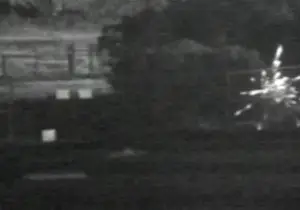
Sparks like these, recorded on surveillance cameras, were among the few traces the shooters left in Metcalf.
The attackers made errors. They left behind their brass (7.62x39mm), and their position marking cairns. Their marksmanship was only so-so — there were a lot of misses — and perhaps more importantly, they engaged some targets that would not have had any systemic effect. The phone lines cut were not sufficient to isolate the substation and the associated installations, so the police were called while the attack was still underway. Still, the shooter(s) were off and away before the police were on scene.
Focus of the Investigation
The focus of the investigation has been on domestic political opposition. Originally, a great deal of effort was made to try to tie this to a series of power transmission attacks in Arkansas, without success, because the author of the Arkansas attacks appears to have been an imaginative singleton. No consideration has been given to the possibility of Mexican Drug Trafficking Organization (DTO) involvement, either on their own behalf or on behalf of anti-American international terrorists; indeed, no consideration has been given to international terrorists at all. Given the way the Arkansas case shook out, the FBI are pretty sure they’re on the right track.
A remote possibility exists that this could have been representatives of the Sinaloa Cartel doing a favor for their BATFE gun suppliers, or the ATF themselves, looking to generate enthusiasm — or pretext — for further gun bans. That sounds far-fetched to the point of paranoid, but these attacks took no lives, and in the past, they did launch a policy that predictably resulted in the deaths of Federal agents. And one of the guys who planned that fiasco is the new director.
The FBI has also made great use of national intelligence agencies’ pervasive surveillance of domestic computer communications. Exactly who is swept up in the dragnet can’t be known, but given that Herschel Smith’s posts predate the attacks, they’ve probably looked at everybody who has looked at those pages. Say hello to J. Edgar, or maybe he’s really Markus Wolf, guys.
Other attacks
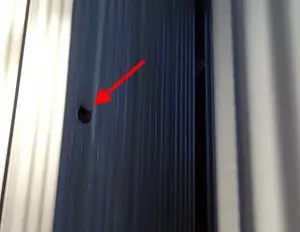
This well (or negligently?) placed gunshot took out a $35,000 transformer in Louisiana. Photo: Claiborne Electric Co-op.
Consider this: Metcalf and Arkansas were clearly attacks, given their complexity and persistence. But there may be other attacks that have not been documented as such. Last year, a Louisiana electric co-op lost a transformer and insulators to rifle fire, but managers aren’t thinking terrorism. They think it’s something the industry has come to accept, unwillingly, as routine: equipment damaged deliberately by armed vandals, or recklessly by irresponsible shooters or hunters.
We’re not sure what’s the worst possibility: these attacks are foreign terrorists or drug kings, or they’re attacks by rogue agents, or they’re just sheer bloody-minded vandalism, destruction for the simple and sick joy of destruction. Each option is pretty dreadful.
And consider this: it might not be a fully-formed plan at this point. It might have been a confidence target, a guerilla’s version of a test flight or shakedown cruise. That’s a lovely concept.
It could be worse
But as bad as the Metcalf, CA attack was, it could definitely have been worse. The West Point Combating Terrorism Center (CTC) sponsored game-theory research into taking down the grid. While the work is theoretical, and mathematically dense, and it assumes a cyber, not physical, attack, the conclusions are clear: an attack on well-chosen nodes could take down one of the three regional/subnational grids; and adding more resources to both sides increases the advantage of the attacker.
We’ve seen a lot of similar attacks on power transmission in Iraq. Some of them are political (or as the faultlines in Iraq are shaping up today, sectarian). Others are just nihilistic vandalism. Once you uncork the bottle, the genie gets a vote.
Prediction: we haven’t heard the end of these attacks.
In the end, last April, Metcalf went offline and PG&E patched around it and limped along for the weeks it took for repairs to bring the substation back online. And it did finally go online, with some new surveillance technology, and something new in place to thwart rifle attacks: opaque screens. This can still be overcome by the offense, of course, but it makes him work harder or select different weapons.

Kevin was a former Special Forces weapons man (MOS 18B, before the 18 series, 11B with Skill Qualification Indicator of S). His focus was on weapons: their history, effects and employment. He started WeaponsMan.com in 2011 and operated it until he passed away in 2017. His work is being preserved here at the request of his family.


